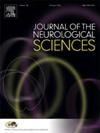乳头水肿消退后特发性颅内高压患者的搏动性耳鸣持续存在
IF 3.2
3区 医学
Q1 CLINICAL NEUROLOGY
引用次数: 0
摘要
背景:乳头水肿通常被用作特发性颅内高压(IIH)的诊断标准和监测进展和治疗的一部分。治疗的目的是降低颅内压,乳头水肿通常随着颅内压的充分降低而消失。然而,颅内高压的相关症状可能持续存在,对生活质量产生不利影响。我们的目的是量化IIH患者乳头水肿消退后搏动性耳鸣的持续时间。方法对2019年9月至2023年10月在我院三级学术神经眼科诊所就诊的IIH患者进行回顾性图表分析。结果246例IIH患者连续被确定,其中132例乳头水肿被记录存在,后来被记录已经解决。73%(97/132)表现为搏动性耳鸣。在搏动性耳鸣患者中,61例(59/97)在乳头水肿消退后仍有持续的搏动性耳鸣症状。持续性耳鸣患者和症状缓解者在年龄、体重指数、乳头水肿等级或出现横窦狭窄方面没有显著差异。结论大部分IIH患者即使在乳头水肿消退后仍存在脉动性耳鸣。需要进一步的研究来描述潜在的机制及其对生活质量的影响。本文章由计算机程序翻译,如有差异,请以英文原文为准。
Persistence of pulsatile tinnitus in patients with idiopathic intracranial hypertension following resolution of papilledema
Background
Papilledema is commonly used as part of the diagnostic criteria for and to monitor progression and treatment of Idiopathic Intracranial Hypertension (IIH). Treatment is aimed at reducing intracranial pressure, and papilledema is typically seen to resolve with sufficient reduction of intracranial pressure. However, associated symptoms of intracranial hypertension may persist, adversely impacting quality of life. Our aim was to quantify the persistence of pulsatile tinnitus in IIH patients after resolution of their papilledema.
Methods
We conducted a retrospective chart review of patients seen in our tertiary academic neuro-ophthalmology clinic for management of IIH between September 2019 and October 2023.
Results
246 consecutive patients with IIH were identified, 132 cases in whom papilledema had been documented to be present and were later documented to have resolved. 73 % (97/132) presented with pulsatile tinnitus. Of the patients with pulsatile tinnitus, 61 (59/97) were documented to have ongoing symptoms of pulsatile tinnitus even after resolution of papilledema. There were no significant differences in age, BMI, papilledema grade, or presence of transverse sinus stenosis at presentation between those with persistent tinnitus and those with resolved symptoms.
Conclusions
Pulsatile tinnitus persists in a large portion of IIH patients even after resolution of papilledema. Further research is needed to characterize the underlying mechanisms and its impact on quality of life.
求助全文
通过发布文献求助,成功后即可免费获取论文全文。
去求助
来源期刊

Journal of the Neurological Sciences
医学-临床神经学
CiteScore
7.60
自引率
2.30%
发文量
313
审稿时长
22 days
期刊介绍:
The Journal of the Neurological Sciences provides a medium for the prompt publication of original articles in neurology and neuroscience from around the world. JNS places special emphasis on articles that: 1) provide guidance to clinicians around the world (Best Practices, Global Neurology); 2) report cutting-edge science related to neurology (Basic and Translational Sciences); 3) educate readers about relevant and practical clinical outcomes in neurology (Outcomes Research); and 4) summarize or editorialize the current state of the literature (Reviews, Commentaries, and Editorials).
JNS accepts most types of manuscripts for consideration including original research papers, short communications, reviews, book reviews, letters to the Editor, opinions and editorials. Topics considered will be from neurology-related fields that are of interest to practicing physicians around the world. Examples include neuromuscular diseases, demyelination, atrophies, dementia, neoplasms, infections, epilepsies, disturbances of consciousness, stroke and cerebral circulation, growth and development, plasticity and intermediary metabolism.
 求助内容:
求助内容: 应助结果提醒方式:
应助结果提醒方式:


